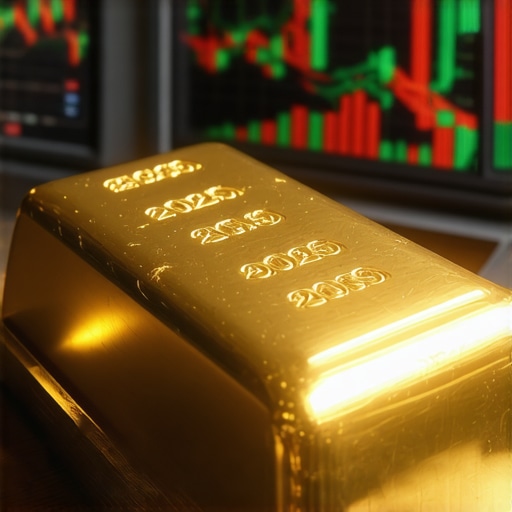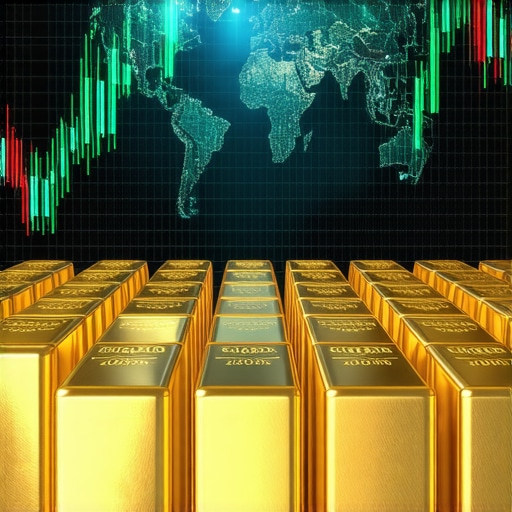How I Realized the Power of Understanding Gold’s Global Supply and Demand
Reflecting back on when I first dipped my toes into gold investing, I remember being overwhelmed by the volatility and the seemingly unpredictable price swings. It wasn’t until I started analyzing the global gold supply and demand dynamics that things began to make sense. I recall spending late nights poring over reports and market data, trying to grasp how factors like mine production, recycling, and central bank purchases influenced prices. This deeper understanding transformed how I approached my investments, making them smarter and more strategic.
Why Tracking Gold Supply Opens Doors to Investment Insights
Diving deeper, I found that gold supply isn’t just about how much gold is mined. It also involves scrap gold recycling and the intricate roles central banks play by buying or selling reserves. For example, when central banks increase their gold holdings, it often signals confidence in gold as a stable asset, which can drive prices up. Observing these supply trends gave me clues about potential market movements before they became obvious to most investors. If you want to explore this further, this detailed guide on gold supply and demand dynamics helped me solidify my knowledge.
How Gold Demand Trends Shaped My Investment Strategy
On the demand side, I discovered that jewelry demand, technology applications, and investment buying all play significant roles. Watching emerging market trends, especially in countries like India and China, where cultural affinity toward gold remains strong, revealed how consumer behavior can impact prices. Plus, investment demand tends to spike during economic uncertainty. Learning about these demand drivers helped me time my purchases better, aligning them with periods when demand was rising, which often led to price appreciation.
What Are the Key Questions Every Gold Investor Should Ask About Supply and Demand?
This question kept me up at night during my early investing days. I realized the importance of asking: How stable is mine production? Are recycling rates increasing or decreasing? What are central banks doing with their gold reserves? And importantly, how are global economic shifts influencing jewelry and investment demand? Understanding the answers to these helped me anticipate market shifts rather than react to them.
Applying This Knowledge to Build a Smarter Gold Portfolio
Armed with insights on supply and demand, I began tailoring my investment approach. I diversified between physical gold bars, coins, and gold ETFs, balancing liquidity with tangible assets. I also kept an eye on authoritative market analyses and forecasts, such as those available at Buying Gold Now, which consistently provided credible, up-to-date information to guide my decisions.
If you’ve had experiences with gold investing or are curious about how global supply and demand influence your investment choices, I’d love to hear your thoughts in the comments. Sharing insights helps us all become smarter investors.
Navigating the Complexities of Gold Market Fluctuations Beyond Basics
While understanding the fundamental supply and demand dynamics is crucial, seasoned investors recognize that market fluctuations often hinge on nuanced factors such as geopolitical tensions, technological disruptions in mining, and evolving regulatory frameworks. For instance, sudden political instability in key mining countries can disrupt supply chains, causing unexpected spikes in gold prices. Similarly, innovations in recycling technology may increase secondary supply, subtly affecting market availability. These intricacies require continuous monitoring and adaptability to maintain portfolio resilience.
The Role of Central Banks: More Than Just Buyers and Sellers
Central banks’ gold transactions often reflect broader monetary policy intentions. Beyond simply increasing reserves, their buying or selling can signal shifts in currency confidence or hedge against inflationary pressures. For example, as highlighted by the International Monetary Fund, central banks utilize gold strategically to diversify reserves and stabilize national currencies during economic turbulence. Understanding these policy-driven moves enables investors to anticipate market trends with greater precision.
How Can Investors Integrate Real-Time Supply and Demand Data into Their Gold Strategies?
In today’s digital era, integrating real-time analytics on mine output, scrap recycling, and central bank activity is paramount. Tools leveraging big data and AI can provide early warnings of supply disruptions or demand surges. Investors might consider platforms offering live market intelligence to time entries and exits more effectively. Additionally, combining this data with macroeconomic indicators, such as inflation rates and currency valuations, enriches decision-making frameworks. This approach transforms reactive investing into proactive strategy optimization, essential for navigating gold’s inherent volatility.
Practical Steps to Leverage Gold Demand Insights for Portfolio Optimization
Tracking consumer demand trends, especially in emerging markets, remains a cornerstone for anticipating price movements. For example, seasonal spikes in jewelry demand around festivals in India or China can create short-term price rallies. Moreover, the rising incorporation of gold in electronics and medical technologies introduces new demand streams that can affect long-term price stability. By monitoring these subtle shifts, investors can align their holdings to capitalize on both cyclical and structural demand changes. For a comprehensive understanding, this resource on gold demand trends offers valuable insights.
Have you utilized real-time supply and demand analytics in your gold investment approach? Share your experiences or questions below to foster a community of informed investors eager to refine their strategies.
Embracing the Complexity Behind Gold’s Supply Chains
As my journey into gold investing matured, I realized that the simplistic view of supply equaling mined gold missed many subtleties. For example, geopolitical risks in top mining countries like South Africa and Russia can abruptly curtail production, sending ripples through the market. I remember a particular instance when unrest delayed shipments, and the price moved sharply before news even hit mainstream channels. This experience taught me that tracking political and social stability in mining hubs is as essential as monitoring production numbers.
Additionally, the role of recycling has become increasingly fascinating. The rise of new technologies improving gold recovery from electronic waste challenges the traditional supply outlook. This evolving secondary supply can dampen price surges if not closely monitored. It pushed me to start following industry reports on recycling trends, often overlooked by casual investors.
The Unseen Influence of Central Banks on Gold Dynamics
While I had previously touched on central bank gold purchases, diving deeper revealed their strategic maneuvers are often tied to broader macroeconomic policies rather than immediate market reactions. The IMF’s detailed analysis helped me understand how these institutions use gold to hedge against currency risks and inflation, especially in uncertain economic climates.
For instance, when a central bank increases gold reserves during periods of quantitative easing, it often signals a lack of confidence in fiat currencies. This insight transformed how I interpret gold price rallies—not just as investor panic but as institutional positioning. It also highlighted the importance of monitoring central bank reports and announcements closely.
How Do Emerging Technologies and Changing Consumer Behaviors Shape Gold Demand?
This question intrigued me as I noticed shifts beyond traditional jewelry and investment demand. The integration of gold in cutting-edge technologies—like electronics, medical devices, and even green energy solutions—has introduced new, sometimes unpredictable demand streams. For example, the growing use of gold in 5G and electric vehicle components subtly boosts demand, but these trends can be volatile depending on technological adoption rates.
On the consumer side, changing cultural preferences and younger generations’ attitudes toward gold jewelry have nuanced effects on demand. In some markets, digital assets are competing with physical gold as stores of value, altering investment patterns. Understanding these layered demand factors has made me more cautious but also more opportunistic, as I seek to align my portfolio with both traditional and emerging demand drivers.
Integrating Real-Time Data and Forecasting into My Investment Routine
With the advent of AI and big data analytics, I’ve started incorporating real-time supply and demand metrics into my decision-making process. Platforms that track mine output fluctuations, recycling rates, and central bank activity in near real-time have become invaluable. Coupling these with macroeconomic indicators like inflation trends and currency movements creates a richer, dynamic picture of gold’s market potential.
This proactive approach has helped me anticipate price swings more effectively and avoid emotional reactions to short-term volatility. For readers interested in sharpening their analysis, exploring resources like this guide on predicting gold price swings offers practical frameworks to harness data strategically.
Have you experimented with integrating real-time analytics into your gold investment approach? Sharing your experiences or questions can spark valuable conversations and collective learning here.
Harnessing AI and Big Data to Decode Gold’s Subtle Market Movements
As technology increasingly permeates financial markets, I’ve embraced advanced analytical tools to sharpen my gold investing acumen. Integrating AI-driven platforms that monitor mine production fluctuations, scrap recycling rates, and central bank gold transactions in real-time has revolutionized my approach. This granular data, when combined with macroeconomic indicators like inflation trajectories and currency strength, forms a multidimensional view of gold’s market pulse. The ability to anticipate supply shocks or demand surges before they become headline news empowers me to act decisively rather than react impulsively.
Moreover, these technologies help filter noise from signal, allowing a focus on fundamental trends amid the volatility. For those serious about refining their strategies, exploring resources such as this guide on predicting price swings offers practical frameworks to harness data effectively.
Emerging Market Shifts: A Nuanced Lens on Gold Demand Evolution
Delving deeper into demand trends, I’ve observed how evolving consumer behaviors in emerging economies redefine gold’s role. Countries like India and China continue to anchor global demand through jewelry and investment purchases, yet subtle shifts are underway. Younger generations, influenced by digital wealth paradigms, sometimes prioritize cryptocurrencies over traditional gold holdings, challenging historical consumption patterns.
Simultaneously, gold’s integration into innovative technologies—from 5G infrastructure components to electric vehicle circuitry—introduces complex demand vectors that are less correlated with traditional markets. Tracking these nuanced demand drivers requires vigilance and adaptability, ensuring my portfolio aligns not only with cyclical spikes but also with structural, long-term trends. For a comprehensive analysis, I often consult this valuable resource on demand trends to stay ahead in the game.
How Can Investors Effectively Balance Traditional Gold Holdings with Technological and Emerging Market Demand Factors?
This question has challenged me to rethink portfolio allocations beyond conventional wisdom. Balancing physical gold—such as bars and coins—with exposure to gold-related equities and ETFs tied to mining innovation or tech integration requires nuanced risk assessment. It’s not merely about diversification but about understanding the interplay between stable, tangible assets and dynamic, growth-oriented demand sources.
In this context, I find it invaluable to regularly evaluate geopolitical stability in mining regions alongside technological adoption rates in emerging economies. For instance, disruptions in South African mining due to labor unrest can tighten supply suddenly, while rapid tech adoption in Asia can spike industrial demand unexpectedly. Such insights are indispensable for crafting a resilient, forward-looking portfolio.
Central Banks’ Strategic Gold Movements: Decoding Policy Signals and Market Implications
Another layer of complexity I’ve unraveled is the strategic nature of central banks’ gold activities. Their transactions often transcend mere reserve management, reflecting broader monetary policy shifts and geopolitical positioning. The IMF’s rigorous study illuminated how central banks deploy gold to hedge against currency volatility and inflationary pressures, especially amid quantitative easing or trade tensions.
Understanding these moves has refined my interpretation of gold price rallies, distinguishing between speculative surges and institutional positioning. Consequently, I monitor central bank reports and global economic policy developments closely, incorporating them into my predictive models for market behavior.
Engage and Elevate Your Gold Investment Journey
Gold investing is a continually evolving discipline, enriched by technological innovation and shifting global economic landscapes. I invite you to share your experiences, challenges, or questions about integrating real-time data or navigating emerging market complexities. Your insights and inquiries not only deepen our collective understanding but also foster a vibrant community of informed investors striving for mastery in this precious metal arena.
Things I Wish I Knew Earlier (or You Might Find Surprising)
The Hidden Impact of Recycling on Gold Supply
Early on, I underestimated how much recycled gold contributes to overall supply. It’s not just about mining output; technological advances in recovering gold from electronics have steadily shifted the supply landscape. Keeping tabs on recycling trends gave me a clearer picture of supply pressures that aren’t always headline news.
Central Banks Are More Than Just Buyers and Sellers
I used to think central bank gold transactions were simple reserve adjustments. But diving deeper, I realized their moves often reflect broader monetary policy signals, currency confidence, and geopolitical strategies. This perspective helped me interpret price movements more thoughtfully instead of assuming they were just market noise.
Emerging Market Consumer Behavior Is a Game-Changer
Watching how younger generations in places like India and China are shifting preferences—from traditional jewelry to digital assets—revealed a nuanced evolution in demand. It reminded me that gold investing isn’t static; it requires adapting to cultural and technological shifts globally to stay ahead.
The Power of Real-Time Data Integration
Incorporating AI and big data tools into my analysis transformed how I anticipate gold price swings. Instead of reacting to news, I began proactively spotting supply disruptions or demand surges early. This shift from reactive to strategic investing was a turning point in my journey.
Balancing Tangible Assets with Market Instruments
I once focused solely on physical gold bars and coins, but gradually saw value in blending these with gold ETFs and stocks. This balance offers both security and liquidity, helping me navigate volatility with flexibility.
Resources I’ve Come to Trust Over Time
Over the years, a few key sources have become my go-to companions for deepening my understanding of gold’s supply and demand dynamics:
- Buying Gold Now’s guide on gold supply and demand dynamics – This resource helped me connect the dots between mine production, recycling, and central bank actions.
- The International Monetary Fund’s analysis on central bank gold reserves and monetary policy – A detailed, authoritative perspective that opened my eyes to the strategic role central banks play.
- Understanding gold demand trends on Buying Gold Now – This helped me appreciate how cultural, technological, and economic factors intertwine to shape demand.
- Predicting gold price swings with real-time data – A practical guide that introduced me to integrating analytics and macroeconomic indicators.
Parting Thoughts from My Perspective
Gold’s supply and demand dynamics are far richer and more intricate than they seem at first glance. From mining disruptions and recycling innovations to central bank strategies and shifting consumer behaviors, every piece plays a role in shaping the market. Embracing this complexity has made my gold investment approach more confident and nuanced.
If there’s one takeaway I hope you carry forward, it’s that staying curious and integrating diverse insights—from geopolitical to technological—is key to mastering gold investing. If this resonated with you, I’d love to hear your thoughts or experiences. Feel free to drop a comment and join the conversation—after all, we all benefit by learning together.










